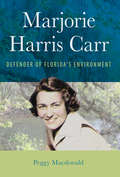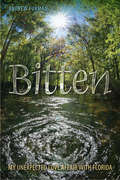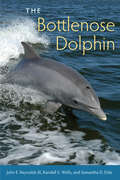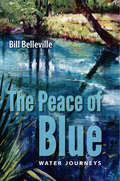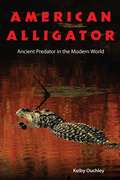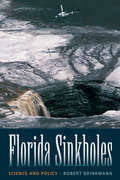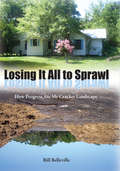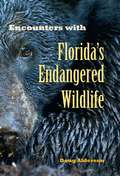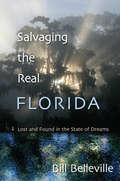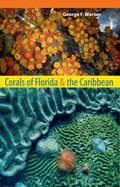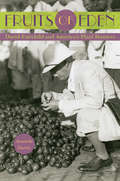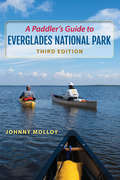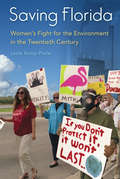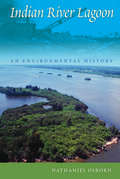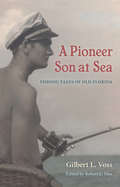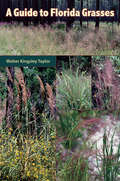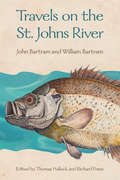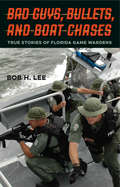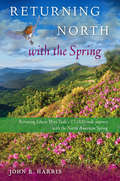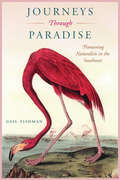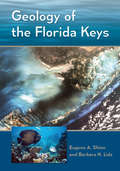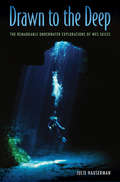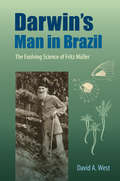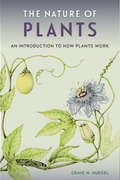- Table View
- List View
Marjorie Harris Carr: Defender of Florida's Environment
by Peggy MacdonaldMarjorie Harris Carr (1915-1997) is best known for leading the fight against the U.S. Army Corps of Engineers’ Cross Florida Barge Canal. In this first full-length biography, Peggy Macdonald corrects many long-held misapprehensions about the self-described “housewife from Micanopy,” who struggled to balance career and family with her husband, Archie Carr, a pioneering conservation biologist.Born in Boston, Carr grew up in southwest Florida, exploring marshes and waterways and observing firsthand the impact of unchecked development on the state’s flora and fauna. Macdonald’s work depicts a determined woman and Phi Beta Kappa scholar who earned undergraduate and graduate degrees in zoology only to see her career thwarted by institutionalized gender discrimination. Carr launched her conservation career in the 1950s while raising five children and eventually became one of the century’s leading environmental activists.A series of ecological catastrophes in the 1960s placed Florida in the vanguard of the burgeoning environmental revolution as the nation’s developing eco-consciousness ushered in a wave of revolutionary legislation. With Carr serving as one of the most effective leaders of a powerful contingent of citizen activists who opposed dredging a canal across the state, “Free the Ocklawaha” became a rallying cry for environmentalists throughout the country.Marjorie Harris Carr is an intimate look at this remarkable woman who dedicated her life to conserving Florida’s wildlife and wild places. It is also a revelation of how the grassroots battle to save a small but vitally important river in central Florida transformed the modern environmental movement.
Bitten: My Unexpected Love Affair with Florida
by Andrew FurmanWhen Andrew Furman left the rolling hills of Pennsylvania behind for a new job in Florida, he feared the worst. While he’d heard much of the fabled “southern charm,” he wondered what could possibly be charming about fist-sized mosquitoes, oppressive humidity, and ever-lurking alligators.It wasn’t long before he began to notice that the real Florida right outside his office window was very different from the stereotypes portrayed in movies, television, and even state-promoted tourism advertisements. In Bitten, Furman shares his amazement at the beautiful and the bizarre of his adopted state. Over seventeen years, he and his family have shed their Yankee sensibilities and awakened to the terra incognita of their new home.As he learns to fish for snook—a wily fish that inhabits, among other areas, the concrete-lined canals that crisscross the state—and seeks out the state’s oldest live oak, a behemoth that pre-dates Columbus, Furman realizes that falling in love with Florida is a fun and sometimes humbling process of discovery. Each chapter highlights a fascinating aspect of his journey into the natural environment he once avoided, from snail kites to lizards and cassia to coontie.Sharing his attempts at night fishing, growing native plants, birding, and hiking the Everglades, Furman will inspire you to explore the real Florida. And, if you aren’t lucky enough to reside in the Sunshine State, he’ll at least convince you to unplug for an hour or two and enjoy the natural beauty of wherever it is you call home.
The Bottlenose Dolphin: Biology and Conservation
by John E. Reynolds III Randall S. Wells Samantha D. EideThe Bottlenose Dolphin presents for the first time a comprehensive, colorfully illustrated, and concise overview of a species that has fascinated humans for at least 3,000 years.After reviewing historical myths and legends of the dolphin back to the ancient Greeks and discussing current human attitudes and interactions, the author replaces myths with facts--up-to-date scientific assessment of dolphin evolution, behavior, ecology, morphology, reproduction, and genetics--while also tackling the difficult issues of dolphin conservation and management.Although comprehensive enough to be of great value to professionals, educators, and students, the book is written in a manner that all dolphin lovers will enjoy. Randall Wells’s anecdotes interspersed throughout the work offer a first-hand view of dolphin encounters and research based on three decades working with them. Color photographs and nearly 100 black and white illustrations, including many by National Geographic photographer Flip Nicklin, beautifully enhance the text.
The Peace of Blue: Water Journeys
by Bill BellevilleThe Earth’s surface is mostly oceans, the human body is approximately 60% water, and the human imagination has been captivated by this life-giving, life-sustaining liquid from time immemorial.According to Carl Hiaasen, Bill Belleville “writes gorgeously and straight from the heart. In The Peace of Blue, the documentarian and nature writer guides you on a lyrical journey to the natural places in Florida and the Caribbean that have been forged and shaped by water. He poetically underscores the vitality of this most essential substance in our lives by showing the many ways in which water-driven landscapes nurture plants, wildlife—and the human spirit.Experience the thrill of traveling to the remote islands of Cuba and to sacred cenotes in the Dominican Republic. Contemplate the shores of Florida’s rivers and lakes and marvel at swamps and seepage slopes. Immerse yourself in the underwater world of clear, fresh springs, and dive into the deep karst caves that are worlds unto themselves.Through adventure and contemplative excursions, Belleville shares his contagious respect—and awe—for the singularity and transcendence of the natural world. We are companions in his search for a distinct sense of place, fellow journeymen in his quest to discover within the watery depths a greater awareness that informs and shapes our common identity.
American Alligator: Ancient Predator in the Modern World
by Kelby OuchleyHaving survived since the Mesozoic era, alligators teetered on the brink of extinction in the 1960s. Their recovery in the 1970s was largely due to legislative intervention, and today populations are closely monitored throughout their range. American Alligator is the most up-to-date and comprehensive treatment of this resilient relic, a creature with a brain weighing less than half an ounce that has successfully adapted to a changing Earth for more than 200 million years.Kelby Ouchley chronicles the evolution of A. mississippiensis from "shieldcroc"--the last common ancestor of modern-day alligators, crocodiles, caimans, and gavials--to its current role as keystone of the ecological health of America's southern swamps and marshes. In Florida, the apex predator uses its snout and feet to clear muck from holes in the limestone bedrock. During the dry season, these small ponds or "alligator holes" provide refuge, food, and water for a variety of wildlife. In Louisiana, millions of dollars are spent on the bounty of the non-native nutria that overgraze marsh vegetation, but alligators prey on these coastal rodents free of charge.The loss of the American alligator would be a blow to biodiversity and an ecosystem disruption affecting all levels of the food chain. While the U.S. Fish and Wildlife Service removed it from the endangered species list in 1987 and today regulates the legal trade of the animal and its products, Ouchley cautions us not to forget the lessons learned: human activities, from urban development to energy production, can still threaten the future of the gator and its southern wetland habitat.
Florida Sinkholes: Science and Policy
by Robert BrinkmannBelow the live oaks, palm trees, cypress swamps, and springs, water is slowly wearing away the limestone bedrock of Florida. The erosion is often unseen, and over time it can result in shocking cave-ins like the destructive spectacle of the 1981 Winter Park sinkhole.Florida Sinkholes--the first comprehensive book on the subject--is an easy-to-follow guide to understanding how sinkholes form and what to do about Florida's sometimes pockmarked landscape. City planners, construction managers, developers, and homeowners alike will find this book invaluable because of the heavy impact and increasing frequency of sinkhole formation in the state. Amateur geologists will be fascinated by the subtle forces of nature that can make solid rock disappear. Tackling the problem of sinkholes in useful detail, this book packs an abundance of sound scientific fact into frank, readable language. Learn about the captivating workings of karst, a term for the swiss cheese-like formations of soluble rock that underlie the peninsula. Discover current state-of-the-art approaches to mapping sinkholes and subsurface voids. Review such practical concerns as structural damage, repairs, insurance problems, and management of karst lands. Examine case studies of several notable sinkholes and sinkhole events. Even before you've finished reading, you may find yourself itching to get out and visit these intriguing marvels of Florida geology for yourself.
Losing It All to Sprawl: How Progress Ate My Cracker Landscape (Florida History and Culture)
by Bill BellevilleLosing It All to Sprawl is the poignant chronicle of award-winning nature writer Bill Belleville and how he came to understand and love his historic Cracker farmhouse and "relic" neighborhood in central Florida, even as it was all wiped out from under him. Belleville's narrative is eloquent, informed, and impassioned, a saga in which tractors and backhoes trample through the woods next to his home in order to build the backbone of Florida sprawl--the mall. As heavy machinery encircles Belleville and his community--the noise growing louder and closer, displacing everything Belleville has called home for the past fifteen years--he tells a story that is much older, 10,000 years older. The story stretches back to the Timucua and the Mayaca living in harmony with Florida's environment; the conquistadors who expected much from, but also feared, this "land of flowers"; the turn-of-the-century tourists "modernizing" and "climatizing" the state; the original Cracker families who lived in Belleville's farmhouse. In stark contrast to this millennia-long transformation is the whiplash of unbridled growth and development that threatens the nearby wilderness of the Wekiva River system, consuming Belleville's home and, ultimately, his very sense of place.In Florida, one of the nation's fastest growing states (and where local and state governments encourage growth), balancing use with preservation is an uphill battle. Sprawl spreads into the countryside, consuming not just natural lands but Old Florida neighborhoods and their unique history. In Losing It All to Sprawl, Belleville accounts for the impacts--social, political, natural, personal--that a community in the crosshairs of unsustainable growth ultimately must bear, but he also offers Floridians, and anyone facing the blight of urban confusion, the hope that can be found in the rediscovery and appreciation of the natural landscape.
Encounters with Florida's Endangered Wildlife
by Doug AldersonEastern bison roamed Florida into the 1800s. Red wolves disappeared in the 1920s. The dusky seaside sparrow was declared extinct in 1990.It's too soon to say whether the 116 threatened, endangered, or imperiled animal species currently found in the state will also fall victim to climate change, extermination, overdevelopment, or poisons. But as long as they remain, there will be men and women who work tirelessly on their behalf.Combining adventure, natural history, and cultural history, Encounters with Florida’s Endangered Wildlife features chapters tracking panthers, black bears, whooping cranes, manatees, sea turtles, even ivory-billed woodpeckers--which may or may not be extinct. Join Doug Alderson as he travels into prairies, woods, springs, and ocean to come face to face with these and other captivating creatures and learns firsthand about their strangled lives and fragile habitats.With a chapter on the impact of non-native populations of Burmese pythons and Rhesus monkeys, as well as a chilling epilogue that imagines the peninsula one hundred years in the future, this book is a must-read for anyone who wants to know more about the current state of wild Florida.
Salvaging the Real Florida: Lost and Found in the State of Dreams
by Bill BellevilleModern life has a tendency to trap people in cubicles, cars, and cookie-cutter suburbs. Thankfully, someone comes along now and then to remind us of the beauty that presents itself when we turn off the information feeds and turn away from the daily grind. Bill Belleville’s enchanting Salvaging the Real Florida invites readers to rediscover treasures hidden in plain sight. Join Belleville as he paddles a glowing lagoon, slogs through a swamp, explores a spring cave, dives a "literary" shipwreck, and pays a visit to the colorful historic district of an old riverboat town. Journey with him in search of the apple snail, the black bear, a rare cave-dwelling shrimp, and more. Everywhere he goes, Belleville finds beauty, intrigue, and, more often than not, a legacy in peril. Following in the tradition of John Muir, William Bartram, and Henry David Thoreau, Belleville forges intimate connections with his surroundings. Like the works of Marjory Stoneman Douglas and Archie Carr, his evocative stories carry an urgent and important call to preserve what is left of the natural world.
Corals of Florida and the Caribbean
by George F. WarnerPresenting a stunning array of beauty and biodiversity, the coral reefs of Florida and the Caribbean are part playground, part research lab for the thousands of tourists, divers, and marine scientists who visit them every year. Documenting the wide array of corals at home in the warm waters of the Caribbean, George Warner's Corals of Florida and the Caribbean provides an easy-to-use (and carry) guidebook that is both scientifically accurate and reader friendly.Warner provides an exhaustive identification guide that will enrich any novice's vacation dive or an expert's return to the reefs. Written for the amateur naturalist, this handbook will travel well throughout the Caribbean, from Florida south to Belize, east to Tobago, and all points in between.Beyond documenting the wide variety of corals found in the Caribbean, Warner also outlines their biology, from the way they grow to their reproductive habits, while examining major threats to the reefs including hurricanes, pollution, and global warming. With over 150 color photos, most taken by the author himself, as well as detailed descriptions, Corals of Florida and the Caribbean makes identifying and learning about corals hassle free--on the boat, at home, or in the classroom.
Fruits of Eden: David Fairchild and America's Plant Hunters
by Amanda HarrisAt the turn of the nineteenth century—when most food in America was bland and brown and few people appreciated the economic potential of then-exotic foods—David Fairchild convinced the U.S. Department of Agriculture to finance overseas explorations to find and bring back foreign cultivars. Fairchild traveled to remote corners of the globe, searching for fruits, vegetables, and grains that could find a new home in American fields and in the American diet.In Fruits of Eden, Amanda Harris vividly recounts the exploits of Fairchild and his small band of adventurers and botanists as they traversed distant lands—Algeria, Baghdad, Cape Town, Hong Kong, Java, and Zanzibar—to return with new and exciting flavors. Their expeditions led to a renaissance not only at the dinner table but also in horticulture, providing diversity of crops for farmers across the country.Not everyone was supportive, however. The scientific community was concerned with invasive species, and World War I fanned the flames of xenophobia in Washington. Adversaries who believed Fairchild’s discoveries would contaminate the purity of native crops eventually shut down his program, but his legacy lives on in today’s modern kitchen, where navel oranges, Meyer lemons, honeydew melons, soybeans, and durum wheat are now standard.
A Paddler's Guide to Everglades National Park
by Johnny MolloyWhether forging uncharted territory or slipping along marked canoe trails, get ready to experience more than 400 miles of creeks, bays, marshes, and the Gulf of Mexico. This indispensable guide for the ultimate adventure by canoe or kayak now includes GPS coordinates and twelve new paddle routes.
Saving Florida: Women's Fight for the Environment in the Twentieth Century
by Leslie Kemp PooleIn Saving Florida, Leslie Kemp Poole casts new light on the women at the forefront of Florida’s environmental movement. From creating parks to protesting air pollution, fighting dredge-and-fill operations, and exposing the health dangers of pesticides, these women caused unprecedented changes in how the Sunshine State values its many and marvelous natural resources.At the beginning of the twentieth century women didn’t have the vote, but by the end of the century they were founding issue-specific groups, like Friends of the Everglades, and running state and federal agencies, including the U.S. Environmental Protection Agency. They set the foundation for the next century’s environmental agenda, which came to include the idea of sustainable development, which meshes ecology and economy to enhance energy efficiency and the function of natural systems.This is an indispensable history that not only underscores the importance of women in the environmental movement but also shows how as a collective force they forever altered how others saw women’s roles in society.
Indian River Lagoon: An Environmental History
by Nathaniel OsbornStretching along 156 miles of Florida's East Coast, the Indian River Lagoon contains the St. Lucie estuary, the Mosquito Lagoon, Banana River Lagoon, and the Indian River. It is a delicate ecosystem of shifting barrier islands and varying salinity levels due to its many inlets that open and close onto the ocean. The long, ribbon-like lagoon spans both temperate and subtropical climates, resulting in the most biologically diverse estuarine system in the United States.Nineteen canals and five man-made inlets have dramatically reshaped the region in the past two centuries, intensifying its natural instability and challenging its diversity. Indian River Lagoon traces the winding story of the waterway, showing how humans have altered the area to fit their needs and also how the lagoon has influenced the cultures along its shores. Now stuck in transition between a place of labor and a place of recreation, the lagoon has become a chief focus of public concern. This book provides a much-needed bigger picture as debates continue over how best to restore this natural resource.
A Pioneer Son at Sea: Fishing Tales of Old Florida
by Gilbert L. VossLong before tourism dominated Florida’s coastline, the state was home to dozens of commercial fisheries and ethnically diverse communities of rugged individuals who made their living from the sea.In A Pioneer Son at Sea, Gilbert Voss, a celebrated marine biologist, recounts his early days of fishing on both coasts of the peninsula during the Great Depression and World War II. Here are vanished scenes from old Florida, almost unimaginable to modern residents of the state: gill-netting for mackerel off Jupiter, the early days of charterboat fishing for sailfish out of Stuart and Boynton, the snapper fleet at Carrabelle, sponge-diving at Tarpon Springs, the oyster fishery at Crystal River, and mullet fishing from airboats at Flamingo.Oversized personalities inhabit these pages, including Voss's brothers, who were themselves seminal figures in the early days of Florida big-game fishing. Voss's anecdotes feature Crackers, rum runners, murderers, Conchs, wealthy industrialists, now-legendary charterboatmen, Greek spongers, and Cuban vivero captains. These stories are not just spirited portraits of fishermen from a bygone era, they are also remarkable tales of the formative years in the life of a scientist and conservationist who later worked tirelessly to preserve our dwindling marine resources.
A Guide to Florida Grasses
by Walter Kingsley TaylorA Guide to Florida Grasses offers an introduction to this vital and frequently neglected plant family. This richly illustrated reference includes complete details pertaining to the identification, structure, distribution, and uses of more than 200 of the most common grasses found in Florida and nearby states. With over 500 color images--some picturing species that have never been described with a published image--correctly identifying and selecting members of this important plant family has never been easier. Environmentalists, hikers, and nature lovers can take this book into the field or enjoy it at home. A Guide to Florida Grasses will be accessible and invaluable to professional botanists, commercial landscapers, homeowners, and plant enthusiasts alike.
Travels on the St. Johns River
by John Bartram William Bartram“The editors skillfully interpret the geography and natural history, and provide an extensive list of the plants and animals the Bartrams encountered. This work will appeal to naturalists and those interested in early American studies in natural history.”—Choice "Bringing together descriptions and illustrations of the St. Johns River and its characteristic flora and fauna from the golden age of natural history exploration, this book will be useful to both Bartram scholars and amateur naturalists."--Timothy Sweet, author of American Georgics: Economy and Environment in American Literature, 1580-1864 "Illustrates the unique sense of place of Florida and, in particular, the St. Johns River. Guides the reader along a transcendent spiritual journey that ends on the shores of ecology."--R. Bruce Stephenson, author of John Nolen, Landscape Architect and City Planner In 1765 father and son naturalists John and William Bartram explored the St. Johns River Valley in Florida, a newly designated British territory and subtropical wonderland. They collected specimens and recorded extensive observations of the plants, animals, geography, ecology, and native cultures of an essentially uncharted region. The chronicle of their adventures provided the world with an intimate look at La Florida. Travels on the St. Johns River includes writings from the Bartrams' journey in a flat-bottomed boat from St. Augustine to the river's swampy headwaters near Lake Loughman, just west of today’s Cape Canaveral. Vivid entries from John's Diary detail which tribes lived where and what vegetation overtook the river's slow current. He describes the crisp, cold spring waters tasting like a gun barrel. Excerpts from William's narrative, written a decade later when he tried to make a home in East Florida, contemplate the environment and the river that would come to be regarded as the liquid heart of his celebrated Travels. A selection of personal letters reveal John's misgivings about his son's decision to become a planter in an inhospitable pine barren with little more than a hovel as shelter, but they also speak to William's belated sense of accomplishment for traveling past his father's footsteps. Editors Thomas Hallock and Richard Franz provide valuable commentary and a modern record of the flora and fauna the Bartrams encountered. Taken together, the firsthand accounts and editorial notes help us see the land through the explorers' eyes and witness the many environmental changes the centuries have wrought.
Essential Oil Research: Trends in Biosynthesis, Analytics, Industrial Applications and Biotechnological Production
by Sonia MalikThis book highlights the advances in essential oil research, from the plant physiology perspective to large-scale production, including bioanalytical methods and industrial applications. The book is divided into 4 sections. The first one is focused on essential oil composition and why plants produce these compounds that have been used by humans since ancient times. Part 2 presents an update on the use of essential oils in various areas, including food and pharma industries as well as agriculture. In part 3 readers will find new trends in bioanalytical methods. Lastly, part 4 presents a number of approaches to increase essential oil production, such as in vitro and hairy root culture, metabolic engineering and biotechnology. Altogether, this volume offers a comprehensive look at what researchers have been doing over the last years to better understand these compounds and how to explore them for the benefit of the society.
Bad Guys, Bullets, and Boat Chases: True Stories of Florida Game Wardens
by Bob H. Lee“Stories are brimming with confrontations and high-stakes action. . . . Lee’s observations radiate authenticity and he effectively conveys his sophisticated knowledge base about the law, the Everglades and the criminal mind and the skill sets of conservation professionals. Once you get into this book, you won’t be able to put it down.”—Florida Weekly “Engaging, humorous, and touching. As we meet this crazy real-life cast, Lee shows us that the true character of those on the frontlines of the fight against wildlife crime is integrity and a commitment to protect animals and landscapes.”—Laurel A. Neme, author of Animal Investigators: How the World’s First Wildlife Forensics Lab Is Solving Crimes and Saving Endangered Species “The job of a wildlife officer is never boring. Lee takes you behind the scenes on patrol—using everything from airboats to airplanes—as he and other state wildlife officers track and apprehend poachers in the Sunshine State.”—W. H. “Chip” Gross, coauthor of Poachers Were My Prey: Eighteen Years as an Undercover Wildlife Officer “Lee’s enlightening and entertaining stories will open your eyes to the duties and responsibilities that these officers perform on any given day.”—Dave Grant, past president, North American Game Warden Museum “Lee provides remarkable insight into a world and culture unknown to most people, revealing the true diversity and dangers of the game warden profession.”—Craig Hunter, director of law enforcement, Texas Parks and Wildlife “These stories convey the feel of the Florida environment, the tedium of the hiding and waiting, the thrill of the chase and capture, and the exhaustion, exhilaration, or heartbreak of the search and rescue. You won’t be disappointed.”—James “Tom” Mastin, consulting forester and principal, Natural Resource Planning Services, Inc. Imagine yourself alone in the wilderness holding two lawbreaking suspects at gunpoint. No onlookers, no backup. Just you in the dark, in the middle of nowhere, with suspects who would cheerfully kill you if they thought they could get away with it. Veteran wildlife officer Bob Lee takes readers deep into the days and nights of Florida game wardens in Bad Guys, Bullets, and Boat Chases. Some people might think that all these officers do is check fishing licenses, but this book tells a very different story, one of shoot-outs, survival, rescue, and powerboat chases. Tracking black-market gator poachers, jumping through truck windows, shredding boat propellers on underwater logs, trapping airboats in wild hog muck, ferrying crates of baby sea turtles, hunting for missing persons in remote areas, getting stuck under a 500-pound all-terrain vehicle at the bottom of a sinkhole—these are just some of the situations game wardens find themselves in. And beyond the action and excitement, the highs and lows of a wildlife officer’s job would test the mental limits of even the bravest adventurer. In these stories, a rookie game warden works to rescue survivors after a jumbo jet crashes in a swamp; an experienced trapper leads a challenging search for a rogue gator after a tragic attack; and a dedicated lieutenant helps a deer poacher turn his life around. From Live Oak to the Everglades, from the cattle ranches west of Lake Okeechobee to the inshore fishing grounds of Pine Island, these amazing experiences span the state. Discover the excitement, dangers, and disasters that game wardens face every day on the job.
Returning North with the Spring
by John R HarrisAt winter's end in 1947, driven by the devastating loss of a son killed in World War II, naturalist Edwin Way Teale followed the dawning spring season northward in an amazing 17,000-mile odyssey from the Everglades to Maine. He wrote about the adventure in North with the Spring. Its sequel Wandering Through Winter won the Pulitzer Prize.Retracing Teale's route, writer John Harris reveals a vastly changed natural world. In Returning North with the Spring, he stops at the very places where Teale once stood, trekking through the Okefenokee wetland, the Great Smoky Mountains, the Great Dismal Swamp, the New Jersey Pine Barrens, and Cape Cod. He is stunned to see how climate change, invasive species, and other factors have affected the landscapes and wildlife. Yet he also discovers that many of the sites Teale described have been newly "rewilded" or permanently protected by the government.Homage to the past, report on the present, glimpse into the future--this book honors what has been lost in the years since Teale's famous journey and finds hope in the small tenacities of nature.
Journeys Through Paradise: Pioneering Naturalists in the Southeast
by Gail Fishman"This book is for those inhabited by the same desires that drove the early naturalists afield, who yearn to know wilder territory. We read it voraciously, as if in the understanding of how they loved we might also begin to do so, as if in the reliving of their lives we might recapture some vanishing part of the human psyche that must know wilderness."-- Janisse Ray, author of Ecology of a Cracker Childhood "Like the naturalists she profiles, Gail Fishman takes us on an odyssey through a time when the extraordinary diversity of the southeastern United States was first being explored and described. . . . Entertaining."-- Steve Gatewood, executive director, Society for Ecological Restoration, Tucson "Fishman modernizes the men and their explorations by retracing the terrain that they explored, wrote about, drew and painted. The result is an intriguing and appealing lesson in biographical and scientific history and a literary reading experience that will appeal to a wide audience."-- William W. Rogers, professor of history emeritus, Florida State University Following the original steps of pioneering naturalists, Gail Fishman profiles thirteen men who explored North America’s southeastern wilderness between 1715 and the 1940s, including John James Audubon, Mark Catesby, John and William Bartram, John Muir, and Alvan Wentworth Chapman. The book is also Fishman’s personal travelogue as she experiences the landscape through their eyes and describes the changes that have occurred along the region’s trails and streams. Traveling by horseback, boat, and foot, these naturalists--dedicated to their task and blessed with passion and insatiable curiosity--explored gentle mountains, regal forests, and shadowy swamps. Their interests ran deeper than merely cataloging plants and animals. They identified the continent’s foundations and the habits and histories of the flora and fauna of the landscape. Fishman tells us who they were and what compelled them to pursue their work. She evaluates what they accomplished and measures their importance, also pointing out their strengths and failings. And she paints an engaging picture of what America was like at the time. Fishman combines natural history and American history into a series of portraits that recapture the American Southeast as it was seen by those who first tramped through the wilderness and whose voices from the beginning urged the preservation of wild places. Gail Fishman, a freelance writer who lives in Tallahassee, has worked for the Florida Defenders of the Environment, The Nature Conservancy, and the National Audubon Society. She is a volunteer for the St. Marks National Wildlife Refuge and helped form the St. Marks Refuge Association.
Geology of the Florida Keys
by Eugene A. Shinn Barbara H. Lidz"A joy to read from two of the most prominent geologists who have worked for the better part of their careers in the Florida Keys. Places important environmental focus on modern-day issues facing the island ecosystems, the health of Florida Bay, the nearshore areas, and ultimately the reef tract."--Donald F. McNeill, University of Miami "A compelling narrative that weaves fascinating historical personalities and periods with the geological characteristics of the Florida Keys into a colorful tapestry. A fun, interesting, and informative read!"--Eugene C. Rankey, University of Kansas Two world-class geologists draw on their prolific fifty-year careers in this comprehensive guide to the geology and biology of the Florida Keys and Florida Bay. Eugene Shinn and Barbara Lidz dive into the past, present, and future of an area that has long been a natural laboratory for learning about coral reef formation and the origins of limestone. They explain how underlying Pleistocene topography controls the shapes of today's coral reefs, how sea-level rise created Florida Bay, and how hurricanes mold limemud banks and strip vegetation from the Florida Keys. They discuss the recent decline of coral reefs due to overpopulation, pollution, climate change, and other factors. An itinerary is included for a hands-on three-day field trip, guiding visitors to the best places to see the famous reef formations and geologic processes of the Keys. As glaciers continue to melt and reform at Earth's poles, sea level is currently rising and will fall again at some point in the geologic future. In this volume, Shinn and Lidz demonstrate the value of the Keys and immediate surroundings as an environmental laboratory to study past effects of sea-level change and to stimulate ideas for further research.
Drawn to the Deep: The Remarkable Underwater Explorations of Wes Skiles
by Julie HausermanDan's Cave looks like the entrance to the underworld. Two divers swim along a luminous blue-green passage, flashlights cutting through the water, a dark mass of stalactites suspended overhead. This is the breathtaking National Geographic cover photo taken by Wes Skiles (1958–2010), a top nature photographer who died in a diving accident before the issue was published. Drawn to the Deep celebrates the life of an extraordinary adventurer who braved extreme danger to share the hidden beauty and environmental truths of the planet with others. Skiles felt a pull to the water as a child, captivated by the cobalt springs of Florida. His passion for diving and his innovative camera techniques earned him assignments with National Geographic and Outside. He also took part in creating over a hundred films, many of which won international awards and acclaim. Skiles was a self-taught expert on Florida's freshwater springs and an outspoken advocate for their conservation. He went head to head with scientists and government officials who dismissed his firsthand observations of water movement through the "Swiss-cheese" karst rock of the underground aquifer. But he never gave up on his quest to disprove the prevailing scientific models or to protest what they allowed—the unchecked pumping and depletion of Florida's groundwater. Through interviews with Skiles's friends and family, along with insights from his own journals, Julie Hauserman describes the escapades and achievements that characterized his life's work. This book is the inspiring story of an explorer and activist who uncovered environmental abuses, advanced the field of underwater photography, and astonished the world with unprecedented views of the secret depths of the planet.
Darwin's Man in Brazil: The Evolving Science of Fritz Müller
by David A. WestFritz Müller (1821-1897), though not as well known as his colleague Charles Darwin, belongs in the cohort of great nineteenth-century naturalists. Recovering Müller's legacy, David A. West describes the close intellectual kinship between Müller and Darwin and details a lively correspondence that spanned seventeen years. The two scientists, despite living on separate continents, often discussed new research topics and exchanged groundbreaking ideas that unequivocally moved the field of evolutionary biology forward. Müller was unique among naturalists testing Darwin's theory of natural selection because he investigated an enormous diversity of plants and animals, corresponded with prominent scientists, and published important articles in Germany, England, the United States, and Brazil. Darwin frequently praised Müller's powers of observation and interpretation, counting him among those scientists whose opinions he valued most. Despite the importance and scope of his work, however, Müller is known for relatively few of his discoveries. West remedies this oversight, chronicling the life and work of this remarkable and overlooked man of science.
The Nature of Plants: An Introduction to How Plants Work
by Craig N. HuegelPlants play a critical role in how we experience our environment. They create calming green spaces, provide oxygen for us to breathe, and nourish our senses. In The Nature of Plants, ecologist and nursery owner Craig Huegel demystifies the complex lives of plants and provides readers with an extensive tour into their workings. Beginning with the importance of light, water, and soil, Huegel describes the process of photosynthesis and how best to position plants to receive optimal sunlight. He explains why plants suffer from overwatering, what essential elements plants need to flourish, and what important soil organisms reside with them. Readers will understand the difference between friendly and hostile bacteria, fungi, and insects. Sections on plant structure and reproduction focus in detail on major plant organs—roots, stems, and leaves—and cover flowering, pollination, fruit development, and seed germination. Huegel even delves into the mysterious world of plant communication, exploring the messages conveyed to animals or other plants through chemical scents and hormones. With color illustrations, photographs, and real-life examples from his own gardening experiences, Huegel equips budding botanists, ecologists, and even the most novice gardeners with knowledge that will help them understand and foster plants of all types.
